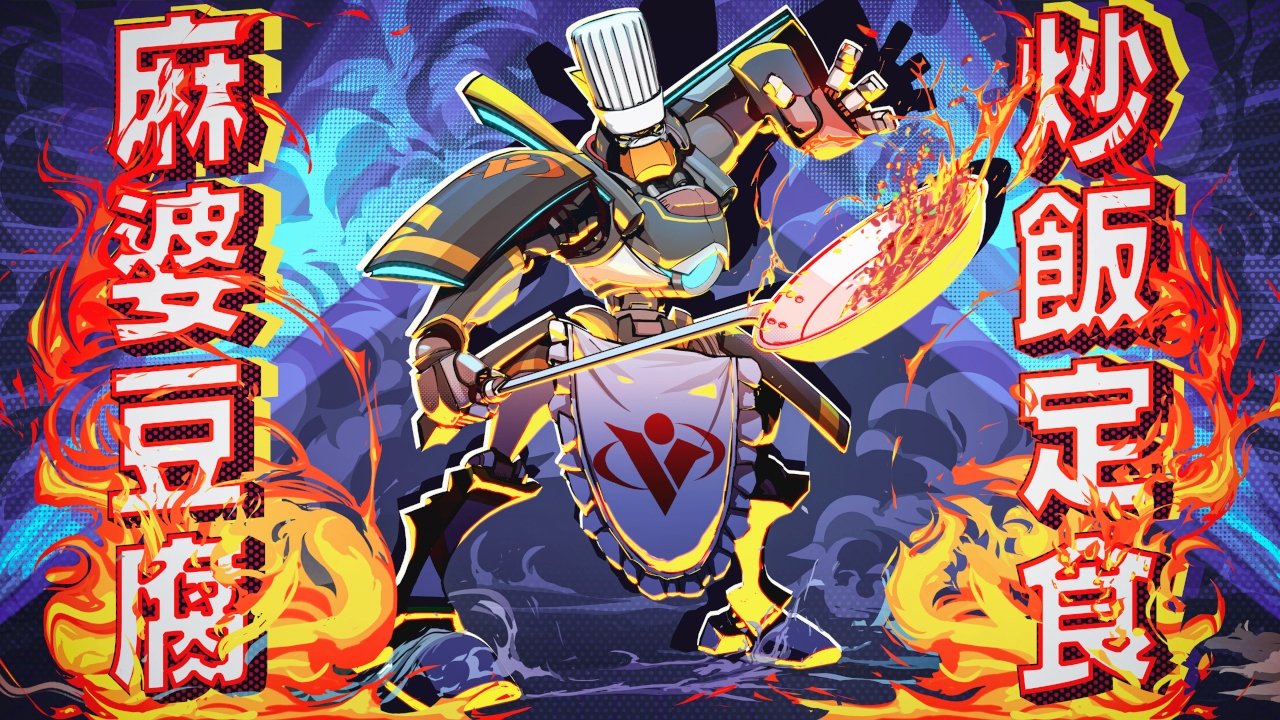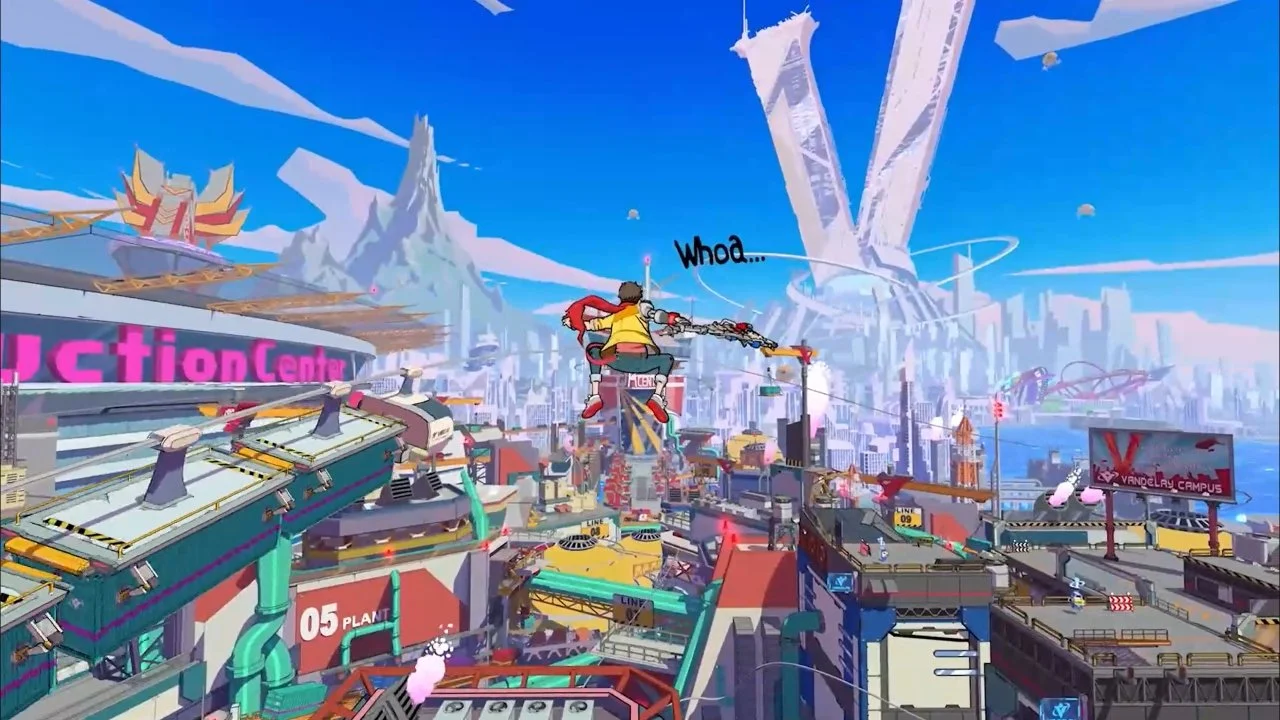Xbox Series X|S review code provided by Bethesda Softworks
Tango Gameworks has long been known for its work in the horror genre, putting out notable releases like The Evil Within and Ghostwire Tokyo. This pedigree comes by way of their founder, Shinji Mikami, the renowned creator of the Resident Evil franchise during his years at Capcom. But all this horror expertise could never have prepared fans for Tango’s latest release.
Hi-Fi Rush was initially announced during the Xbox Developer Direct on January 25th, 2023, and subsequently released later that same day. The reveal showed off a high-octane and brightly colored video game where the entire world grooves to the beat of the MP3 player embedded in the main character’s chest. It marks a startling transition for Tango, and it’s likely to be one that will change the trajectory of the developer forever.
Story
Hi-Fi Rush doesn’t waste any time dropping you into its story. Chai, a wannabe rockstar who doesn’t quite know how to play the guitar, signs up to be experimented on by a dubious company known as Vandelay Technologies. He goes to their massive island compound, straps in for his new robotic enhancements, and ends up with an MP3 player where his heart should be.
Now the entire world bops along to the musical beating of Chai’s heart, offering a narrative explanation for both the rhythm action gameplay and Chai’s sudden increase in combat ability. It’s a wacky story that could have easily slipped into utter ridiculousness if not for the incredible writing, pitch-perfect pacing, and wonderful cast of characters that both oppose and support Chai on his journey.
Before long, Chai is being hunted by the directors of Vandelay as they seek to destroy what they see as a defect in their production line. Chai is aided in his escape by Peppermint, a rebel who’s trying to expose Vandelay’s corruption and stop the nefarious plans behind the experiment that gave Chai his powers. To do so, they’ll need to take down each of the six department heads and recover their access codes.
While this type of story has been done before, Hi-Fi Rush stands out by virtue of its stellar cast and polished dialogue. Chai himself is a comedic juggernaut, brought to glorious life by the inimitable Robbie Daymond. He’s that lovable idiot who always teeters on the edge of being truly profound before revealing himself to still be a naïve kid. In spite of this, Chai still manages to have a powerful, transformative arc that reveals the kind and caring hero underneath that childlike exterior.
The supporting cast is no less wonderful. Peppermint is the emotional core of the game, providing Chai with purpose while also driving the central plot points. Macaron is a burly pacifist who grounds Vandelay in its more benevolent past, showing that there are still good people within this seedy corporation. And each of Vandelay’s department heads is a riot and masterclass in character design, from Mimosa’s operatic persona to Zanzo’s on-the-nose anime aesthetic.
The one thing tying it all together is some of the most hilarious, well-timed writing a video game has ever produced. Every joke lands with careful precision and none of it feels forced or overdone. The game is chock full of meta references, puns, and slapstick humor, but it balances all of that with genuine tension and real stakes. Simply put, it’s a comedic triumph.
Gameplay
Hi-Fi Rush’s big draw is the rhythm action of its entire world. That constant beat thrumming throughout the game doesn’t just impact combat, but everything around Chai. The environment itself moves on his beat, including traps and obstacles he needs to navigate around. It doesn’t feel like it should be possible to make a game this way, and yet Hi-Fi Rush pulls it off with near-perfect execution.
Combat in this game utterly sings, regardless of your experience with rhythm games. The beat is consistent, making it easy to stay on the beat with each swing, dodge, parry, or combo. You can even have the beats on the screen visually, a wonderful accessibility option that’s only a single button press away.
Stringing attacks together and pulling off combos feels like a dream, and Tango has added several brilliant touches here that turn Hi-Fi Rush into one of the best-feeling action games of the last decade. Chai can latch on to enemies with his magnetic arm and pull himself to them, making it easy to close with distant foes and keep combo chains going.
Chai can also call allies into battle with him, taking advantage of their unique abilities to stun enemies and rob them of defensive abilities. This goes even further once you’ve unlocked a few extra attacks, as each ally can also be called in during combos or after a perfectly timed dodge or parry. These special attacks deal massive damage, boost your rhythm meter, and keep the combo going, adding an intrinsic incentive beyond just looking extremely cool.
The scoring system for each battle and stage also boosts replayability, challenging players to dive back in for a higher score or to try and make it through a stage without taking any damage. A challenge list also offers huge payouts when reaching certain milestones or pulling off difficult feats, and each completed challenge fills in a massive mural on the wall of your hideout.
All of these combat elements culminate in some of the best boss battles in video game history. Facing off against each of the Vandelay department heads is a stage unto itself, and each director approaches combat with a unique, delightful style. The Korsica fight in particular stands out as one of the most enjoyable boss battles in recent memory while also making the most of the game’s rhythmic trappings.
The moments between battles are just as interesting, as Tango has built a dense world that’s filled with hidden items and special challenges. While the levels themselves are fairly linear, there’s a decent amount of exploration made possible by brilliant world design. I found myself combing through each level on my first playthrough then diving right back in to root out every last upgrade while pursuing some of the post-game content.
Even after you roll credits, there’s still plenty to do. Secret doors scattered throughout each level open up, unlocking difficult challenges that actually continue the story of the main game. One of your allies also introduces a new mode that pits Chai against waves of enemies and a steadily ticking timer. You’ll need to keep your combo count high and finish unique attack sequences to keep the clock from running out.
The only issues I had with this game were extremely minor, but there were a few frustrating moments with both the dodge and parry not registering properly against certain enemies. Some of the later boss battles can also get a bit grueling with how visually busy the screen gets. Predicting their attack patterns is downright impossible when the visual cue is a small blink while ten other particle effects are floating around them at the same time.
But that frustration paled in comparison to what is otherwise an exemplary gameplay experience. Everything from the combat to the exploration is meticulously designed to provide constant rewards to the player and still vibe to the overall beat of the game. It’s an incredible feat of engineering and design that has set a new standard for the industry.
Audio and Visual
Hi-Fi Rush absolutely oozes style. This is one of the most artistic games ever made, and it deserves every accolade come awards season. The music is, as expected, a focal point of the game, and they absolutely crushed it with their music design. Both the licensed tracks and original scoring fit beautifully, and synchronizing the gameplay to the music had me tapping my foot throughout each play session.
Beyond the music though, the world itself is just a symphony of sound. Each gear, piston, platform, geyser, and footstep falls perfectly in sync, creating a steady rhythm that never falters. For a rhythm game to be this devoted to every element of sound is incredible, and it truly is an auditory feast.
As if the audio design wasn’t enough, Tango blew it out of the water with the visual design. Hi-Fi Rush wears its influences proudly on its sleeve, from anime sensibilities to the adrenaline-soaked, comic book nature of the entire world. It’s vibrant, colorful, and energetic in a way that simply doesn’t feel real.
This all culminates in a beautiful video game that always manages to have a surprise around every corner. Some new visual delight is waiting in each level, from the volcanic caverns below the R&D department to the towering citadel of lasers that makes up the Security wing. It’s a joy to live in this world, and I cannot wait to explore more of it in future installments.
What It Could Have Done Better
There’s very little in Hi-Fi Rush that needs improvement. While I did have some latency issues with dodging and parrying, it’s hard to say for certain if that’s a game issue or just user skill. The one thing I would have liked was the ability to swap out my loadout on the fly. The special pins that augment your abilities can only be changed in the hideout or at one of Peppermint’s hacked displays, which means you’re stuck with whatever you have equipped for the majority of each stage.
One other improvement I’d like to see is the ability to pull up the challenge menu at any time. You can only see this list while in your hideout which makes clearing specific challenges a little more frustrating. I’d have preferred it simply be an option in the pause menu right alongside the combo list.
Verdict
Hi-Fi Rush is a joy thanks to stellar writing, innovative combat, and an endearing cast of characters I’ll be thinking about fondly for years to come. Hi-Fi Rush has been a dizzying experience from its surprise announcement to the joy of actually playing it just a few hours later. Tango Gameworks may have been known for its horror games before, but this game has altered its identity forever.
Hi-Fi Rush is available now for Xbox One, Xbox Series X|S, and PC.





















